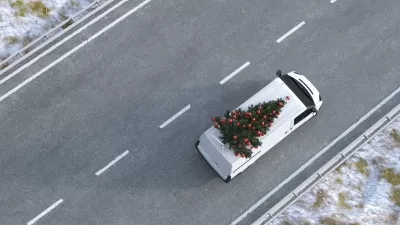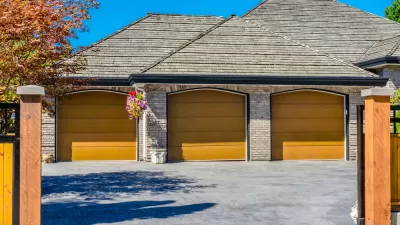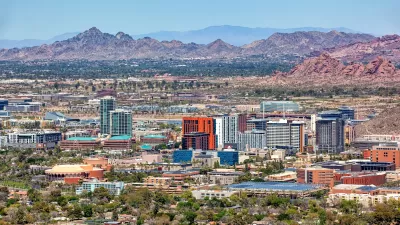I put my Christmas wish in a little early this year—wanted to give Santa time to deliver, and it's not an easy wish to grant. No data, no graphs, no citations, just some thoughts to share.

The awareness of, interest in, and expectations of the transformation of transportation through the integration of technologies that ultimately lead to automated vehicles is now a daily topic in business and contemporary media. The virtual demise of paper maps replaced by navigation apps, the surge in work-at-home in lieu of commuting to work, the marked declines in brick and mortar store traffic as e-commerce continues to ramp up, and the increasing prevalence of transportation network companies and bikeshare programs are among the consequences of technologies changing transportation and changing the business models whereby transportation is provided. A common future vision has automated vehicles and drones playing a major role in mobility and many envision the transformation of transportation to mobility-as-a-service (MaaS) dramatically reducing individual vehicle ownership.
So what's a planner to do?
The pace of change in transportation is creating a critical conundrum for transportation planners and policymakers. One of the planners' roles is to broker information that informs decision-making. But what in the world do we tell decision-makers? Who should one believe regarding the pace and impacts of transportation technology deployment? The public seems captive to the size of the prognosticators' corporate book value, the length of the resume, or the bravado in the acclamations. Nobody want to question Elon Musk or Bob Lutz regarding their statements about automated vehicles. The dilemma is exacerbated by the fact that well credentialed, sincere professionals have radically different perspectives on what will happen and when. Perhaps somewhat awestruck, the planning and policy community have tolerated this uncertainty with deference to proprietary information and competitive pressures shielding the private sector from serious discussions about deployment details and timeframes while the public sector is pushed back on its heels as it deals with regulatory uncertainty, political transition, and their own limited understanding of the pace of technology development, deployment, and customer acceptance.

Rules and suggestions requiring that future transportation plans address emerging technologies are meaningless in the absence of clear direction regarding how to do that. In most cases, the further into the future we forecast, the more uncertain things are. For transportation the opposite now appears to be true, as there seems to be a consensus that ultimately we will have automated mobility-as-a-service playing a significant role. The uncertainty revolves around the pace and nature of the path toward that ultimate endpoint. The next few decades, the sweet spot for transportation planning, will be the most uncertain. In the meantime, policy makers are struggling with very real and critical issues, such as the merits of building expensive rail projects that will require decades to amortize while the competitive environment that they operate in may dramatically change well before the benefits of such investment are captured. Similarly, the prospects that automated technologies can increase throughput of existing infrastructure or mitigate demand by virtue of communication substitution for travel, can undermine the motivation for significant capacity expansion for roadway systems. Policymakers are left in a Catch-22 situation where doing nothing or implementing traditional infrastructure and service options each has very high risk. If the planning community cannot develop a meaningful way to help inform decisions, planners risk becoming marginalized and irrelevant, ceding influence on policy makers to other stakeholders and furthering the cynical attitude of many toward the bureaucracy of government. Planners need to both find constructive strategies and investments for moving forward that respond to uncertainty and develop methods of evaluating plan options in light of the present reality.
Various forums have explored a host of strategies to help plan for an automated future, with discussions of concepts like scenario analysis, uncertainty analysis, robustness, flexibility, adaptability and more. Some individuals have explored characterizing new mode concepts for integration into travel choice models. Simulation analyses have explored fleet size requirements and levels of service necessary for automated vehicles to meet demand. Researchers are assessing the improvements in traffic flow enabled by reduced incidents and smoothed traffic flow attributable to smart vehicles. Others have explored modifications in land use patterns as presumably no-longer-necessary parking space is redeployed for other purposes and site access is redesigned for interface with automated vehicles. Infrastructure modifications to accommodate emerging technologies have been explored and the automated versus connected debate has progressed with the betting line, as measured by corporate investments, not necessarily the merits of the arguments, appearing to favor full autonomy because it is perceived to be possible to execute without relying on government provided infrastructure and minimizes the government's regulatory involvement relative to a vehicle-to-infrastructure and vehicle-to-vehicle connected future. Policy planning folks are anxious and preparing to engage such that public interest helps steer the evolution of transportation so the transportation future is not wholly dependent upon the pace of technology evolution, private business strategies, and customer acceptance.
But mostly planners are still at the "worry about it" stage. The two key issues, 1) the level of travel demand in an automated vehicle world and, 2) the necessary infrastructure and service capacities in an automated vehicle world, remain unresolved and contentious. Close on the heels for attention is assessment of the impacts of an automated future. The foundational goals driving most of transportation planning and programming activities may be rendered dramatically less relevant. The critical externalities of travel that planners have attempted to mitigate through minimizing personal vehicle travel and modifying demand may no longer be as relevant. All modes may be extremely safe, diminishing intermodal differences and dampening the virtues of minimizing travel. In an era of electrified vehicles and sustainably sourced electricity production, energy use and vehicle emissions may similarly diminish in relevance. Additionally, if one believes the scenarios, travel monetary costs may be significantly reduced by virtue of sequentially and simultaneously shared vehicles with travel time "costs" diminished by virtue of travelers being able to pursue other activities while traveling, as they are relieved of driving responsibilities. Even the infrastructure requirements of transportation with their inherent costs and physical disruption may be rendered far less relevant if throughput in existing travel corridors is dramatically enhanced via automation.
Access to travel choices might be nearly ubiquitous with travel very affordable and extremely safe — or maybe not.
The changes associated with technology are not the only changes afoot. Demographics are changing as well with increased diversity, significant changes in household structure and composition, and meaningfully different growth patterns across geography as one-third to one-half of the counties in the U.S. are shrinking or not growing. Business and employment location decisions are less influenced by access to raw materials and more flexible and dynamic in an increasingly service and information based business climate. Growing metro and mega metro regions are influencing government structure and functioning. Financial resources are scarce and often dependent on complex partnerships and debt financing. There are questions regarding the core values, culture, and behavior of the public as diversity across age cohorts, geography, political affiliation, race/ethnicity, and income/wealth status, complicate decision making and dampen enthusiasm for compromise and consensus..
Planning as we know it today, needs to change. And not just a little change, not just a tweaking of the mode choice options, a tweaking of the evaluation criteria or increasing the set of scenarios considered. Just as transportation is transforming, the planning community should do a thorough reevaluation and transformation of transportation planning processes and methods. I do not pretend to know what all those changes might be, but several things seem to need attention.
The stakeholders: technology is invigorating and changing the transportation community. We are on the cusp of a dramatically new set of stakeholders with substantial interest by the private sector. One of the benefits of the transformation of transportation is that the computer industry, technology community, investment community, and others are joining the traditional construction interests, travelers, and the government stakeholders. Even the government stakeholder list is invigorated as the financial, policy, and other aspects of transportation futures have garnered the attention of policymakers. Traditional interests reflecting the traveling community, environmental considerations, and other factors remain, but the mix and balance of stakeholders must change. This begs different engagement strategies and perhaps different mechanisms for discerning goals and creating strategies for addressing travel needs.
Transportation planning has already embraced more sophisticated and technology-leveraged means of communicating with stakeholders and soliciting input, such as by utilizing social media. However, much more will need to be done to incorporate, leverage, and synthesize inputs from this more diverse and larger set of stakeholders.
The goals: one of the biggest challenges for planning is to discern the goals and visions and to define the "problem" that is addressed by the plan. Core goals for transportation are likely to remain similar: equitable access to mobility, safety, efficiency, affordability, and minimized externalities remaining critical. As we have learned more about how transportation interacts with the broader natural, built, and social environments, our goal sets for transportation have grown more comprehensive. However the linkage between these goals and actions or planning proposals are destined to change markedly. To the extent that technologies are successful in attaining the benefits frequently touted, there is the prospect of a significant change in the relationship between various transportation initiatives and the subsequent consequences. The biggest challenge in addressing many of today's transportation problems (beyond resources) is the inherent challenge of enhancing mobility while simultaneously minimizing or mitigating the consequences of those actions that enhance mobility. Going forward, this fundamental challenge, which confounds much of transportation planning today, might be substantially moderated by virtue of safe, low cost, space efficient, sustainably fueled, non-emitting transportation services. Should such performance metrics for transportation materialize, the performance differences across transportation options or modes could be substantially minimized for several parameters such that more subtle nuances might drive decisions. For example, smart technologies might result in all modes having good and similar safety performance with safety performance no longer differentiating between options. Additionally, differences in energy use, emissions, noise, speed, travel time, cost, and other factors might similarly be expected to narrow and decline in magnitude. The fundamental relationship between transportation and land use could also be transformed as the low cost of travel (in both time and money) and limited externalities minimizes the impedance between origins and destinations.
The solutions: whether a plan involves physical infrastructure elements, transportation services, or policies and programs, the nature of the elements in a plan is likely to change dramatically. Traditional modal silos are likely to diminish or disappear as the plethora of modal variations and business models for transportation clouds today's modal definitions. Future plans should acknowledge uncertainty and strive to come up with robust actions across a variety of future scenarios, ensuring adaptability as conditions change. This may favor actions that are reversible or adaptable to changing conditions, or with benefits that accrue quickly in order to be captured before changing circumstances influence the competitiveness of the action. Given increasingly complex built environments and funding and decision-making mechanisms, the design of actions will be inherently more complex creating an opportunity for innovation and creativity to help craft solutions to complex challenges.
The nature of planning activities and solutions for growth versus no growth versus declining markets could be very different. Adapting and sustaining existing infrastructure and services may comprise the totality of planning in stable or shrinking markets. In some communities existing infrastructure systems may no longer be affordable requiring abandonment of some facilities. There may be no compelling need for traditional long-range planning in some markets and contexts. Some communities may not have the resources to direct toward long-term initiatives nor certainty regarding what long-term investments have merit. The negative stigma of the "do-nothing" option might have to be reformed if the alternative is to do something that might have previously appeared as progressive but now is an imprudent public risk in light of the pace of changes.
Evaluation and decision-making: given the changes afoot, evaluation and decision-making regarding plans and programs need to be redesigned. While performance-based decision-making is gaining favor, extrapolating this evidence-based decision-making framework in the context of a highly uncertain future will give planners challenges as they seek ways to assess risk and uncertainty. While tactics and strategies are available, integrating them into a comprehensible transparent planning process will be no small challenge. Evaluation metrics will have to capture the impacts of investment timing and correctly value the time stream of benefits, not just design year numbers.
Implementation: the prospects of a more private sector intensive transportation future will inevitably create challenges as the dominant model of government as the transportation infrastructure planner and provider and private individuals as the vehicle owners and travel decision-makers potentially evolves into a mobility-as-a service model. Moving toward a multi-jurisdiction, multi-stakeholder transportation program and project implementation will challenge the planning community and potentially jeopardize the pace of progress in our very contentious decision-making environments. Balancing diverse interests, discerning the public good, and sorting out the respective roles and responsibilities will continue to challenge planners moving forward.
The magnitude of changes facing transportation merits a thorough reevaluation of planning processes and methods going forward. As the importance of transportation to the environment, economy and quality of life has been better understood planning has evolved to integrate this new information into our planning activities. New goals have arisen, new strategies have materialized, new performance metrics have been deployed, and new decision making strategies have arisen. But the pace of change in technology and transportation has accelerated and planners would be well served by giving their planning processes a thorough checkup.

The opinions are those of the author – or maybe not – but are intended to provoke reflection and do not reflect the policy positions of any associated entities or clients. [email protected]. For a review of prior Seasons Greetings: All I Want for Christmas Is a Transportation Infrastructure Plan That Helps, All I Want for Christmas Is a Driverless Car, New IPhone App Fails Government Transportation Funding Support Criteria, Digging Holes.Special thanks to James Brasuell for keeping my musings comprehensible, focused and within the bounds of the language.

Depopulation Patterns Get Weird
A recent ranking of “declining” cities heavily features some of the most expensive cities in the country — including New York City and a half-dozen in the San Francisco Bay Area.

California Exodus: Population Drops Below 39 Million
Never mind the 40 million that demographers predicted the Golden State would reach by 2018. The state's population dipped below 39 million to 38.965 million last July, according to Census data released in March, the lowest since 2015.

Chicago to Turn High-Rise Offices into Housing
Four commercial buildings in the Chicago Loop have been approved for redevelopment into housing in a bid to revitalize the city’s downtown post-pandemic.

Google Maps Introduces New Transit, EV Features
It will now be easier to find electric car charging stations and transit options.

Ohio Lawmakers Propose Incentivizing Housing Production
A proposed bill would take a carrot approach to stimulating housing production through a grant program that would reward cities that implement pro-housing policies.

Chicago Awarded $2M Reconnecting Communities Grant
Community advocates say the city’s plan may not do enough to reverse the negative impacts of a major expressway.
City of Costa Mesa
Licking County
Barrett Planning Group LLC
HUD's Office of Policy Development and Research
Mpact Transit + Community
HUD's Office of Policy Development and Research
City of Universal City TX
ULI Northwest Arkansas
Town of Zionsville
Write for Planetizen
Urban Design for Planners 1: Software Tools
This six-course series explores essential urban design concepts using open source software and equips planners with the tools they need to participate fully in the urban design process.
Planning for Universal Design
Learn the tools for implementing Universal Design in planning regulations.



























